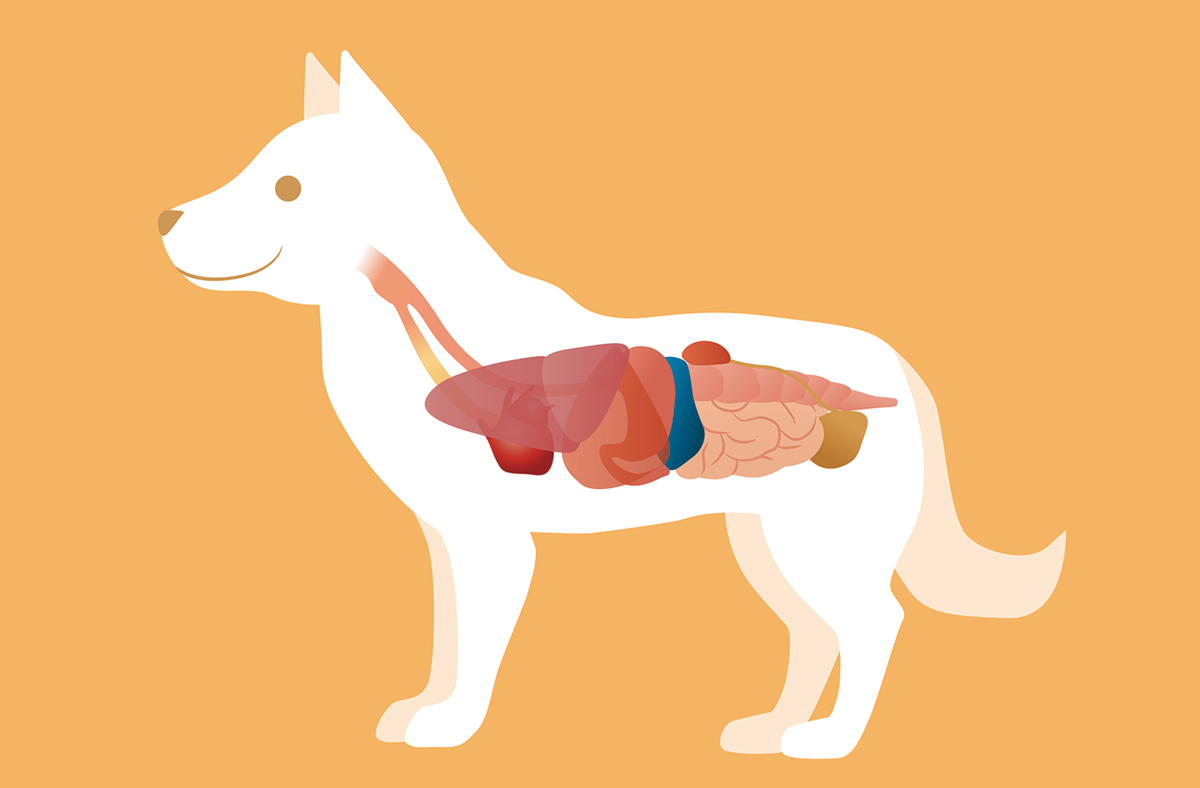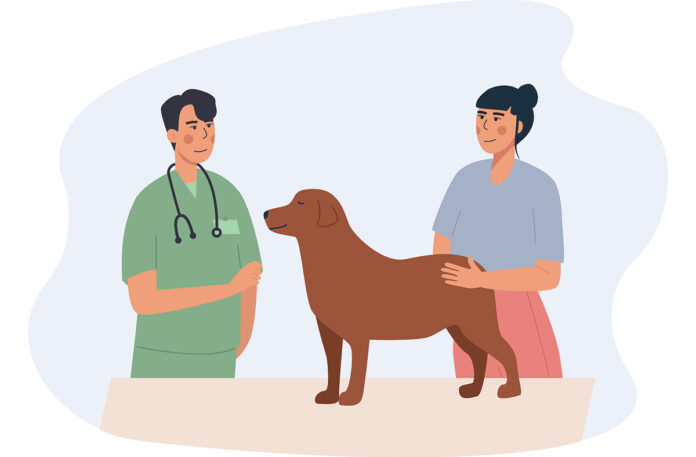Definition of the Disease
Addison’s disease, also known as hypoadrenocorticism, is defined as diminished hormone production from the cortex of the adrenal gland. The adrenal cortex can be damaged by hemorrhage, mineralization or infection, among other things. Addison’s is a potentially life-threatening disorder of the endocrine system which cannot be cured but, if caught early, can be controlled.
How Addison’s Disease Affects Dogs
The signs of Addison’s are caused by an inability or insufficiency of the adrenal glands to produce the necessary amounts of mineralocorticol hormones. This, in turn, causes there to be abnormally low levels of sodium and chloride, and abnormally high levels of potassium, in circulation. Ultimately, this leads to low blood volume, and kidney and heart abnormalities. The signs of this condition tend wax and wane, ranging from mild to severe, and include weakness, lethargy, anorexia, vomiting, regurgitation, diarrhea (possibly bloody), weight loss, poor skin and coat condition, abdominal pain, drinking more water than normal, urinating more than normal, trembling and collapse. Some affected dogs will deviate from normal activities for no apparent reason due to the pain and muscle weakness that can accompany this disease. The signs are normally progressively frequent and increasingly severe, as the dog’s body becomes damaged from the effects of insufficient adrenocorticoid production. Normally, by the time a dog is diagnosed with Addison’s, emergency medical treatment is needed. Once the dog has been stabilized, proper assessment can be made and proper treatment protocols can be prescribed. Addison’s disease is more common in young to middle-aged female dogs, although dogs of any age or sex can be affected.

Causes of Addison’s Disease
The cause of primary Addison’s disease is not always known but is thought to be the result of atrophy of all layers of the adrenal gland, which is probably immune-mediated. Other causes are overdose of certain medication, metastatic tumors and granulomatous disease. Secondary Addison’s can be caused by injury to or disease of the pituitary gland and, more commonly in dogs, by long-term corticosteroid administration which leads to decreased secretion of ACTH and, in turn, reduced synthesis and circulation of glucocorticoid hormones.
Prevention
There is no way to actually “prevent” hypoadrenocorticism in dogs. The recommended approach for dogs with primary Addison’s disease is to continue glucocorticoid hormone replacement therapy for the lifetime of the animal, and possibly to increase the dosage of replacement hormones during periods of particular stress. Reliable tests are available to diagnose this disease, and there are good treatment protocols for managing the condition.
Special Notes
If left untreated, or if diagnosis is delayed, Addison’s can become life-threatening, primarily due to elevated potassium levels and low sodium and chloride levels which cause serious and acute dehydration, volume depletion and problems with the heart and other organs. This is called an “Addisonian crisis” and, if not treated aggressively, can be fatal. The prognosis for dogs with Addison’s is usually very good if the condition is detected early in its course. Unfortunately, diagnosis can be difficult because the clinical signs of Addison’s mimic those of many more common ailments.
Symptoms of Addison’s Disease in Dogs

Hypoadrenocorticism, more commonly called “Addison’s disease” in dogs, is a disorder of the endocrine system which results from insufficiency or inadequate activity of the adrenal cortex. Addison’s is treatable with an excellent prognosis if the condition is detected, treated and monitored early in its course. Unfortunately, diagnosis can be difficult because the clinical signs of Addison’s mimic those of other more common ailments, such as renal failure, liver disease and gastrointestinal disorders, and these signs can wax and wane over time. However, watchful dog-owners normally are able to spot the symptoms of Addison’s, even though they may not know what is causing them.
Predispositions
Addison’s disease is more common younger to middle-aged female dogs, although dogs of any age or gender can be affected. It is unclear whether there are breed predispositions to this disease, but some authorities suggest that Great Danes, West Highland White Terriers, Bearded Collies, Standard Poodles, Rottweilers, Basset Hounds, Labrador Retrievers and Portugese Water Dogs are at increased risk.
Clinical Signs
Owners of dogs with Addison’s usually report that their pets demonstrate signs that come and go over time and range from mild and intermittent to very severe. These include weakness, lethargy, anorexia/lack of appetite, vomiting, regurgitation, diarrhea (that may be bloody), weight loss, abdominal pain, drinking more water than normal (polydipsia), urinating more than normal (polyuria), shaking/trembling and possible collapse. Another possible sign is if a dog deviates from things it usually does. For instance, if a dog shies away from jumping on a couch or bed that normally is not a problem for them, the owner should take note. That’s because pain and muscle weakness can also be symptoms of this disease. Obviously, all of these signs are somewhat vague and commonly ascribed to many other, more common disorders.
If left untreated, or if diagnosis is delayed, Addison’s can become life-threatening, primarily due to elevated potassium levels (hyperkalemia) and low sodium levels (hyponatremia) which cause serious and acute dehydration, volume depletion and problems with the heart, and other organs. Called an “Addisonian crisis,” the symptoms in this situation are among the same as those described above; they are just much more severe in their presentation. If an Addisonian crisis is not treated immediately and aggressively, death can result.
Diagnosing Addison’s Disease
Hypoadrenocorticism in dogs (more frequently called “Addison’s disease”) is difficult to diagnose because its clinical signs are vague and mimic those of so many other, more common disorders. Your veterinarian may only focus on Addison’s after eliminating these other canine problems. Prompt diagnosis is crucial; if left untreated, this disease can lead to and acute and life-threatening medical crisis. However, once diagnosed, treatment can be effective and control of the symptoms can be swift.
Diagnosing Addison’s Disease in Dogs
Most veterinarians seeing a dog with general signs of lethargy, weakness, abdominal pain, vomiting, diarrhea, anorexia and weight loss will recommend an initial database of blood work (complete blood count and serum biochemical profile), and a urinalysis. The results of these tests can suggest Addison’s and support a tentative diagnosis – particularly if they show low sodium (hyponatremia), low chloride (hypochloremia), high potassium (hyperkalemia) and high blood urea nitrogen (BUN) levels in the blood. However, these tests will not be conclusive for the presence of Addison’s disease. Your veterinarian will take a history and conduct a physical examination of your dog. With Addison’s, your dog may be dehydrated and may have a slower than normal heart rate, called “bradycardia.”
The most definitive confirmatory test for hypoadrenocorticism is an ACTH stimulation test. ACTH (adrenocorticotropic hormone) is a hormone that in normal dogs stimulates the adrenal glands to produce what are called “corticosteroids”, including glucocorticoids and mineralocorticoids. In a dog with normally functioning adrenal glands, the ACTH stimulation blood test will show an increase in blood cortisol after the dog is given an injection of ACTH.
In dogs with Addison’s disease, administration of ACTH will cause no or only minimal increase in blood cortisol levels. This may seem simple, but the clinical signs of Addison’s match the symptoms of so many more common diseases that other diagnostic tests normally are done before an ACTH stimulation test. The results of these preliminary tests can point a veterinarian toward further testing for Addison’s. For example, the dehydration caused by vomiting and diarrhea, two signs of Adddison’s, leads to increased waste products in the dog’s blood. This will show up in a serum biochemistry profile as increased blood urea nitrogen (BUN). Elevated BUN is also suggestive of kidney disease. Because at a certain point Addison’s disease may mimic kidney disease, dogs that have elevated BUN levels, are given fluids and then improve dramatically may not have renal disease at all. Addison’s may be the culprit.
Only a veterinarian can definitively diagnose Addison’s disease. Although the diagnosis may take a bit of time and several different tests, it is possible for this disease to be caught in plenty of time for effective treatment and management to begin. It is up to the dog owner to immediately seek veterinary help when the symptoms of hypoadrenocorticism are noticed.
Treating Addison’s Disease in Dogs
Addison’s disease, medically known as hypoadrenocorticism, is potentially life-threatening condition in dogs which cannot be cured but, if caught early, can be treated and controlled. The signs of Addison’s are caused by an inability or insufficiency of the adrenal glands to produce the necessary amounts of adrenocorticol hormones for use by the body. These signs tend to wax and wane over time. Hypoadrenocorticism can cause a variety of symptoms in dogs ranging from mild gastrointestinal upset to acute collapse.
The disease normally causes progressively frequent and increasingly severe signs, as the dog’s body becomes damaged from the effects of insufficient cortisol production. Normally, by the time a dog is definitively diagnosed with Addison’s, emergency medical treatment is needed for an addisonian crisis. Once the dog has been stabilized, proper assessment can be made and proper treatment protocols can be prescribed. Treatment for Addison’s focuses on stabilizing cortisol levels and minimizing any harmful symptoms, such as shock, vomiting or diarrhea, that the disease caused before treatment began. Normally, the owner will be able to treat their dog at home through oral medications and supportive care.
Treating Addison’s Disease
The aggressiveness of treatment for Addison’s will depend in large part on the dog’s clinical status at the time it arrives at the hospital. Dogs suspected of being in an acute addisonian crisis should be treated immediately as if they have hypoadrenocorticism, even before the disease is confirmed. Waiting for the results of an ACTH stimulation test may result in the dog’s death. The goals of treatment include replacing bodily fluid volume, correcting electrolyte imbalances and providing an immediate source of corticosteroids. Treatment of severe Addison’s symptoms includes placing the dog on intravenous fluids (usually normal saline) and giving injections of appropriate glucocorticoids. Dogs often show marked improvement within 24 hours of treatment. ACTH stimulation testing should be done after the dog is stabilized.
In most cases, treatment of Addison’s disease will need to be continued for the rest of the dog’s life. After fluid levels are restored and hormone levels are stabilized, and after the dog has recovered from any other adverse effects of the disease, the owner can take the dog home. Chronic treatment will involve lifelong oral supplementation with corticosteroids, the choice of which will be made by your veterinarian based upon whether your dog’s Addison’s is primary or secondary. Addison’s patients should have urine and blood tests performed periodically to monitor their cortisol and electrolyte levels. If elevated blood potassium levels persist, the dog may need additional drug therapy.
The prognosis for dogs with Addison’s disease is excellent as long as the owner is conscientious about daily drug treatment and periodic veterinary monitoring through blood and urine tests. Excellent communication between owners and their veterinarians can be critical to the success of treatment for this disease.






